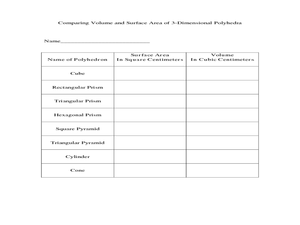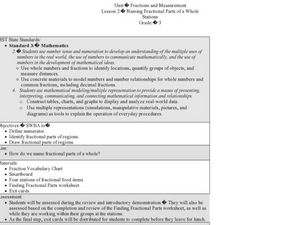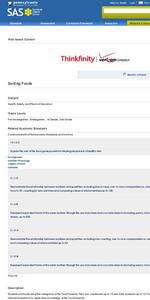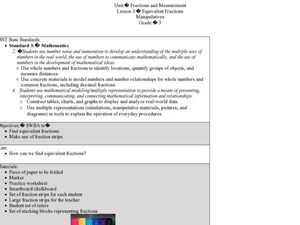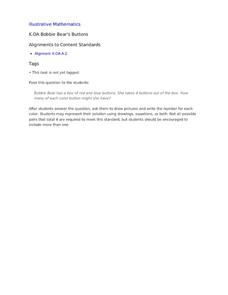Curated OER
How are Seeds Alike and Different?
Second graders examine the seeds in fresh fruit. In this seeds instructional activity, 2nd graders view different seeds and tell how they are alike and different. Students separate the seeds into groups according to their...
Curated OER
Fractions
First graders use Hershey chocolate bars to practice fractions. In this fraction lesson, 1st graders review different fractions and figure out different ways to represent fractions with the pieces of the Chocolate bar. This lesson...
Curated OER
3-D Attributes
Students explore geometric solids. In this geometry lesson, students listen to the book The Greedy Triangle by Marilyn Burns, then work in groups to sort geometric solids into various categories. Students define geometric solids...
Curated OER
Shapes
Students identify attributes of different geometric shapes. In this geometry lesson plan, students view a PowerPoint presentation on shapes and use attribute blocks to examine the corners and edges of each shape. Students work...
Curated OER
The Value of Volume
Students measure the perimeter and area of their polygons. In this geometry lesson, students calculate the volume and area using the correct tools. They calculate the time and temperature and the perimeter and side lengths of triangles.
Curated OER
Fraction Fun
Students practice identifying common fractions using various manipulatives. They visit a visual fractions website and complete an activity. In the final activity, students create real-life problems.
Curated OER
Ball games
In this ball games worksheet, students read a passage about ball games and answer multiple choice questions about it. Students complete 5 multiple choice questions about ball games.
Curated OER
International Festival: Venezuela
Students become familiar with the Venezuelan culture and geography. In this Venezuelan Festival lesson, students compare and contrast themselves to the people of Venezuela. Students participate in activities to understand the...
Curated OER
Paper Plate Aerobics
Students participate in physical activities with paper plates under their feet. In this paper plate aerobics lesson, students make original routines consisting of a series of moves and play tag,
Curated OER
Barter and Trade
Students explore the concepts of bartering and trading. In this algebra lesson, students barter with each other for different items. They use special cards to designate ownership of an item as they explore the complexity of bartering.
Curated OER
Naming Fractional Parts of a Whole
Third graders complete a worksheet. In this fractions lesson plan, 3rd graders review fraction vocabulary, use the SmartBoard to divide fractions and complete stations where they work with fractional parts of a whole.
Curated OER
Sorting Foods
A basic lesson plan on sorting awaits your charges. They sort a variety of foods while using the food pyramid, and identify the role of the food guide pyramid in helping people eat a healthy diet. Learners use an internet tool to apply...
Curated OER
Big Bones, Little Bones
Students investigate archeology. In this archeology instructional activity, students research the process of excavation. Students participate in a mock-excavation and sort objects by physical properties.
Curated OER
Equivalent Fractions Manipulatives
Students study fractions. In this equivalent fractions instructional activity, students utilize fraction strips to enhance their understanding of equivalent fractions. They watch a demonstration and then work independently with their own...
Curated OER
Octopus Legs
Students have oceans of fun transforming a wienie into an octopus they can eat! After counting, cutting halves and fourths, observing steam and the effects of heat, they mix colors as they create a yummy dipping sauce from mustard and...
Curated OER
Reflections Of
Pupils create angles using mirrors. In this angle reflection lesson, students draw angles, then use mirrors to create angles using reflections and measure the new angles.
Curated OER
Fun With Addition
Students name numbers to 30, use the number keys on the computer, use manipulatives to add, and add numbers in any order. In this addition lesson plan, students learn the language of sum, equals, and a plus sign.
Curated OER
Length Word Problems
What's the length? Youngsters are introduced to measurement with this set of word problems. Learners measure three objects, one for each question, based on units provided. The units aren't specified (centimeters, etc.). This is...
Curated OER
What's Hatching in Kindergarten?
Students identify oviparous animals. They brainstorm a list of animals that lay eggs, read "Chickens Aren't The Only Ones" by Ruth Heller and then add to the list. Students complete a booklet that shows an egg and an oviparous animal.
Illustrative Mathematics
A Bobbie Bear's Buttons
Young mathematicians help Bobbie Bear pick colored buttons out of a box as they learn how to decompose numbers less than 10 into pairs of smaller numbers. To support learners with the process, consider creating a worksheet or graphic...
Public Schools of North Carolina
Math Stars: A Problem-Solving Newsletter Grade 5
Looking for a way to challenge the problem-solving abilities of your young mathematicians? Then look no further. This collect of newsletter worksheets engages learners with a variety of interesting word problems that cover topics ranging...
Public Schools of North Carolina
Math Stars: A Problem-Solving Newsletter Grade 2
Develop the problem solving skills of your young learners with this collection of math newsletters. Covering a variety of topics ranging from simple arithmetic and number sense to symmetry and graphing, these...
Public Schools of North Carolina
Math Stars: A Problem-Solving Newsletter Grade 3
Make sure your class stays up with the times using this series of math newsletters. Including word problems that cover topics ranging from consumer math and symmetry to graphing and probability, these worksheets are a...
ESL Kid Stuff
Intro ESL Lesson (Ages 8-14)
Introduce language learners to class behavior expectations, and each other, with activities that include greeting and name games, conducting a class survey, and creating a classroom rules poster.




